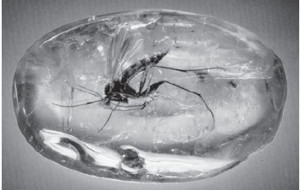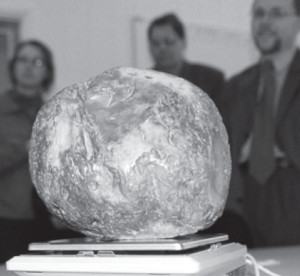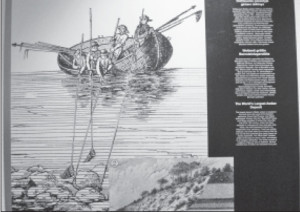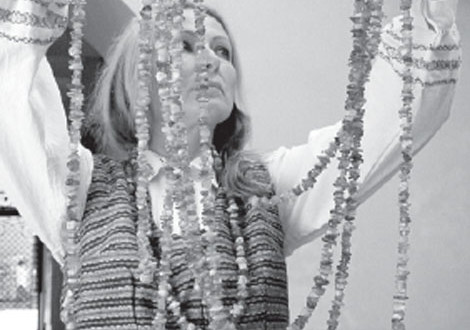By Leif Brost

Amber, a fossilized tree resin millions of years old, has fascinated civilizations for millennia. This fascination continues to this day.
LITHUANIANS REGARD AMBER AS THEIR “GOLD.” Others refer to Baltic amber as the “Gold of the North.” While amber can be found throughout the world, the finest comes from the southern shores of the Baltic Sea.
There are many museums dedicated to showcasing amber, both in Europe and elsewhere. One of the finest is the Amber Museum in Palanga, Lithuania.
Another, perhaps less known, is the Swedish Amber Museum in Höllviken, located close to sandy beaches in the southwestern corner of Sweden, across the strait from Copenhagen, Denmark.
Leif Brost is the director and curator of the Swedish Amber Museum. He is also the co-author with Ake Dahlstrom of The Amber Book, an authoritative study about amber, its history, properties, facts and legends, and how to tell fake amber from real amber. The following article describes the museum in general and amber in particular.
* * *
When the storms begin in the autumn, the local people head for the beach to search for the “Gold of the North.” Maps at the museum give a hint about good locations. Anyone can find a pebble, but the one-kilo pieces and bigger are very rare. Amber from coastal erosion is transported along the shores of all the countries around the southern Baltic Sea. Its weight is slightly heavier than the water in the Baltic Sea. It floats like a soap on the bottom, following the streams until it comes up on the shore or sinks in shallow water. Sometimes it is mined in clay deposits or found among the quartz sand. In saturated salt water it floats. (Melt a couple of spoons of salt in a cup of water and test your amber.)
History and trade
The museum shows artifacts from the Stone Age through the Viking Age, to the jewelry of today.

During the Middle Ages, prayer beads were exported as the main product of tooled Baltic amber. From the 16th century into the 18th century, bracelets, necklaces, containers, boxes, bowls, plates, flutes, buttons, mouth pieces for pipes, chess sets, watch cases and even luxury interior fittings were made using amber. The bulk of the amber trade took place in Königsberg and Danzig, modern Russia, Poland, and Lithuania respectively. In Rome, during the reign of Nero, Romans travelled to the coast of Germania to purchase amber. One expedition proved so successful that a special “amber day” was arranged, where this costly item was used to decorate the gladiator games. In the protective netting between spectators and the arena, a glittering amber ornament was placed within each knot and the actual arena was apparently strewn with amber! During that time, the southwest coast of the Baltic Sea was the most important supplier. The Romans maintained regular trade connections with northern Europe along the so called “Amber Routes.” Even earlier, amber was revered by the Phoenicians, who traveled the seaway to what is today the Danish western coast. Grave-finds from all countries around the Baltic Sea prove that earlier amber was a common trade object to Stone Age man. Since prehistoric times amber has thus been a readily sought after material. Its color, luster, warmth, aroma, electric properties and background, in a scientific sense, place amber in a special category among ornamental stones.
Amber and magic
In days gone by, amber was acclaimed to possess the power of healing. Worn as a necklace or charm, or carried around in small bags, amber was believed to be a remedy against such ailments as gout, rheumatism, sore throats, toothache, and stomachache. It was also believed that amber accelerated birth and was a good remedy against snake bites. To guard against the swapping of a new born baby, the infant was often given an amber necklace to wear. Amber was supposed to contain magical powers, which is why heart-shaped amber charms were carried to offer protection against evil forces and help against witchcraft.
Amber facts
During the Roman times, higher prices were paid for small amulets in amber than for healthy slaves. In 79 AD, Plinius wrote that the women of northern Italy wore amber beads against thyroid problems. Martin Luther carried a piece of amber in his pocket as a protection against kidney stones. In ancient China it was customary to burn amber during large festivities. This practice both signified the wealth of the host as well as honoring the guests. According to Mohammed, a true believer’s prayer beads should be made of amber. The father of healing, Hippocrates, declared amber active against a number of diseases including delirium tremens. Over 2500 years ago, Thales of Miletos discovered that when amber was rubbed against cloth, sparks were produced and then the amber attracted husks and small wooden splinters. This force was given the name “electricity” after the Greek word electron which means amber.

Authentic and false amber
In the displays, the Swedish Amber Museum also explains about how to tell the difference between true, treated, and false amber. Amber is often sold heated, melted and pressed, or even mixed with or made from synthetic materials. Most true Baltic amber is milky and pale under the crust. The warm “amber” color occurs first after it has been exposed to oxygen for about a hundred years. To make amber more attractive to the purchasers, today’s industrial amber jewelry producers are manipulating to get the warm brownreddish amber color, which often also includes discs, called “sunspangles.” The most common method to make amber clear is to put the material under pressure and heat in an autoclave together with nitrogen. After this procedure, it is put into an oven to obtain the “sunspangles” and the cognac color.
This heating and treating is made to make amber jewelry more attractive. Baltic amber occurs naturally in a variety of colors: white, yellow, brown, black, red, green and blue. The most common are honey-colored and milky. A small percentages is bone white, due to microscopic gas bubbles. The clear and translucent amber results from flowing and dripping resin. This kind often shows layers from continuing flow on already dried resin. The black and dirty brown colors are caused by a mix of resin, soil and plant fragments. The most rare have a tone of green or blue caused by gas or inclusions. If the craftsman keeps part of the natural shape, when sanding the raw amber, the crust or inclusions give a natural variety of multicolored tones. It is possible to melt amber pebbles and press them to bigger lumps. It then becomes harder, and less brilliant when cut. Any color can be added in this procedure. This pressed amber is still considered as natural amber by some producers.
Plastic copies
Since the bakelite and plastic era began early last century, there has been a number of fake amber qualities in the commercial market. Bakelite necklaces were sold in Europe in the early twenties, when amber was in fashion. In the markets in Morocco, North and East Africa, as well as in the Middle East and India, amber-colored plastic necklaces are very common. They are often sold as antique trade beads. Sometimes they are old, very beautiful, large egg-yolk colored strands, but they are still plastic, and tend to be heavier than amber. The original, real trade beads, which were distributed from northern Europe around 300 years ago, are very rare to find in the market. It is difficult to see the difference, but if a heated needle is put into the hole of a bead, the smell of burned plastic immediately appears. Baltic amber smells like pine resin. Even without heating the needle, you can tell the difference. Plastic is elastic, and the needle gets stuck in the material, but true amber is brittle and small pieces will chip off by the pressure. A scientist from the British Museum of Natural History, found a falsification in their collection. A very well preserved fly was described as a paleontological rarity from the beginning of the 19th century. Someone had divided the piece and carved a concave hole and then put the fly in and covered it with an “amberlike” material before gluing the halves together again.
Since the “Jurassic Park” movie, fortune hunters from all over the world have tried to create attractive plastic imitations with inclusions, sold as true amber. Sometimes even mammalian hair and feathers are skillfully baked in. They are often carved as a Buddha or other figures, sometimes presented with lumps of the same plastic material with a surface that looks like a natural amber crust. To complete the imitation, the faked raw lumps are dipped in oil with a smell of resin.
Copal, young resin
Resin has always oozed to protect trees all over the world, and the process is still going on. The older the resin, the harder it is. It takes millions of years for the resin to harden to amber. When the resin is younger than one million years, it is called copal, a product traded as raw material for varnish and lacquer before the modem synthetic products were developed. In New Zealand, copal was mined and exported all over the world in the beginning of the last century. Today the industrial remains are shown in museums on the North Island. Among the large pieces in the showcases there are quite a few with perfect lizards and giant spiders enclosed, the result of a kind of melting technique used by the miners. There are almost no inclusions in the New Zealand “Kaurigum” copal, opposed to the very fossil-rich copal from East Africa and Colombia.
Copal turns sticky and smells like fresh resin if heated. It does not take a good polish and the crust comes back in a few years. It is transparent in a champagne color and very brittle. There are different sources in many places, varying in age from a couple of thousand years to one million years.
Is amber forever?
Unfortunately, amber is not forever. Roman beads, 2000 years old, have developed a new thick crust. The Baltic amber jewelry from the last centuries has the fine net of new crust on the surface. It is possible to polish it, but it is very difficult with the faceted kind of jewelry that was common at that time. Some amber from the Dominican Republic crusts already after 10- 20 years. In the Museum Für Naturkunde in Stuttgart, Germany, their valuable collections of inclusions are preserved in plastic coating to keep them from the devastating oxygen. Only the amber deep down in geological deposits has “survived” since it oozed from the trees. So, what is found today is only very little of all the resin the trees have produced during millions of years.

“Jurassic Park”
In the wake of the movie “Jurassic Park,” the interest in amber with inclusions has been increasing rapidly. In the movie, scientists extracted DNA from dinosaur blood enclosed in the stomach of mosquitoes in amber. Through cloning, real dinosaurs were created, and the rest of the story you probably already know. Scientists from the British Museum of Natural History, are now after years of testing, questioning if earlier DNA extractions are contaminated. No successful experiments proved so far. Most amber found today was formed during the Tertiary Age, about 30-50 million years ago, after the dinosaurs were extinct. In a few places such as Lebanon, New Jersey, USA and Alava, Spain, amber from the age of the dinosaurs (65- 220 million years ago) has been found, but in very small amounts.
Realistic science
What the movie above all contributed to among scientists all over the world was an increased awareness of how extremely well inclusions in amber are preserved. After millions of years they are visible in three dimensions, showing microscopic details clearly. They may even show behavior or “stories” from the bottom of the prehistoric forests. The prehistoric conifers, (pinus succinifera), from which Baltic amber originates, were growing in a subtropical climate in what today is northern Europe. Due to its light weight, Baltic amber was an easily transportable material during the formation of bed deposits during the ice ages. Much of the amber found today has been relocated several times. Different kinds of amber are found throughout the world. The amber from the Dominican Republic and Mexico comes from a leaf tree, which grew in tropical climate.
USA exhibitions
After showing our collection of Baltic amber at the Tucson Mineral show, the Amber Museum in Sweden has been invited to exhibit rare specimens at natural history museums all over USA. In our exhibitions there are many pieces, including 40 million year old “frozen stories.” Some contain insects trapped in the sticky resin during their mating act; others show behavior, like ants transporting eggs or carrying away trapped prey. Other specimens include insects caught by spiders, sometimes wrapped up in webs, microscopic arthropods on rotting leaves, fungus growing on dead substances, pollen falling out of the anthers of a flower, small mites riding on beetles, and many more. These frozen moments from the floors of the prehistoric forests can teach us much about the fauna and flora at that time. Scientists can compare inclusions in amber with today’s similar species and study the development through the ages.
The insects in amber are very much the same as the ones living today. Their evolution began 350-400 million years ago. When trapped, they were in the early Tertiary Age (30-50 million years ago), already similar in appearance to today’s insects. The mammals were beginning to develop during this era, and a few inclusions of mammalian hair are found, as well as some bird feathers and reptile skin pieces. Recently an entrapped lizard in amber was found in the Gdansk area in Poland.
 DRAUGAS NEWS Lithuanian World Wide News in English
DRAUGAS NEWS Lithuanian World Wide News in English
